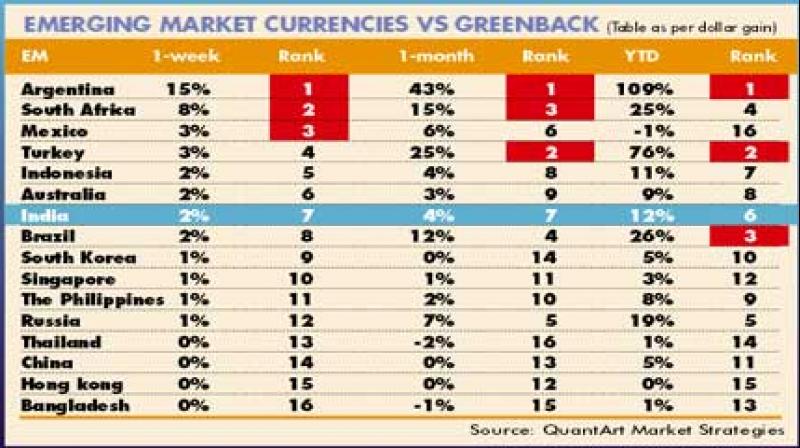RBI sells USD 1.5-2 billion to guard rupee from crossing 72-mark
Jaitley blames global factors, says rupee better off compared to other currencies.

Mumbai: A slew of domestic and global negative cues weighed on the Indian rupee that continued its weakening streak for the sixth consecutive session on Wednesday. The domestic currency hit a fresh lifetime low of 71.79 against the dollar. The rupee has lost 165 paise in the last six trading sessions.
Finance minister Arun Jaitley speaking to journalists in New Delhi attributed the steep fall in rupee to global factors alone. He claimed that the domestic unit was better off as compared to other currencies.
"If you look at the domestic economic situation and the global situation, there are virtually no domestic reasons which are attributable to this. The reasons are global," he said.
A look at the table shows that the rupee has performed worse than some other emerging market currencies, but better than Argentine peso and South African rand.
The dollar has strengthened against almost every other currency and added that the rupee has consistently either strengthened or remained in a range.
"It has not weakened...The rupee is better-off," Jaitely said, adding that the rupee has strengthened against other currencies like the British pound and the euro.
The rupee opened at 71.45 against the dollar and recovered slightly in the opening trade to 71.38, up by 18 paise from Tuesday’s closing of 71.56 but failed to sustain the gains and went into losses in the morning trade after the August services PMI data was released. During the day, it hit a fresh low of 71.97 a dollar but recovered mildly on the intervention from the central bank.
According to traders, the Reserve Bank of India (RBI) sold nearly $1.5-2 billion to stem the rupee’s fall. “RBI's intervention was around $1.5-2 billion in the local spot foreign exchange market to stem a sharp fall in the Indian currency. RBI sold dollars to guard the rupee from crossing the Rs 72/$1 mark decisively," Tickernews Service quoted a senior official with a foreign bank as saying.
However, a dealer with a private sector bank has put the RBI intervention at around $1-1.5 billion.
Rising oil prices pose a risk to India’s current account deficit. The April-June quarter CAD (current account deficit) has widened to 2.6 per cent of GDP (gross domestic product), which was the highest in last four-and-half-years.
The rupee has been the worst performing currency among Asian currencies and so far this year has weakened by 11 per cent. A strong dollar and expectation of several rate hikes by the US Fed have made foreign investors bearish on India. Foreign investors have sold $488.60 million and $5.75 billion in equity and debt markets, respectively.
Besides the Indian rupee, other emerging market currencies such as Indonesian rupiah (down 10.10 per cent), Turkish lira (down 75.19 per cent), South African rand (down 25.42 per cent), and Russian rouble (down 18.82 per cent) also fell against the dollar.
Says Anindya Banerjee, currency analyst at Kotak Securities, “Locally, the norms enacted by Sebi on beneficial ownership of FPI funds by NRIs and also fear of tightening of norms for investments flowing non-FATP compliant countries is causing distress amongst foreign investors. Globally, weakness in EM currencies is being caused by fear of fresh tariffs from US on Chinese imports as well as high oil prices is leading to weakness in rupee. However, we expect the central bank to step into sell dollars to protect the Rupee. Over the near term, volatility can be high. A range of 71.00 to 72.50 is expected.”
Samir Lodha, forex hedging strategist at QuantArt Market Solutions, said: “Two methods of intervention can be effective; a) Japanese style intervention when central bank comes with let’s say $10-20 billion and drive down the level from 72 to 70 or 69. Speculators will think twice before playing against rupee again. However, this is not the style which RBI uses (b) Next one is policy changes. Like curbing buying of dollar-rupee in exchange, tinkering with PP Limit for importers and exporters, raising rates and sound hawkish, changing FII debt limit, offering booster to NRI for deposits ( like done last time) etc.”
“While I am personally not a fan of such schemes, but we can expect such policy changes to come soon. And that will stabilise the dollar-rupee exchange rate,” Lodha added.
Surging dollar hits emerging markets hard
A strengthening US dollar and trade war tensions renewed a sell off in emerging market stocks and currencies. Emerging market stocks fell to a two-week low on Wednesday with Indonesia being at the forefront of the downside move, with stocks falling 3.76 per cent while the Rupiah fell at a near 20-year low against the US dollar.
“Growing divergence between the stable markets in developed economies and uncertainty and volatile emerging markets is likely to persist. We expect trade weakness to show up in the data soon, EM capital flows to weaken further, and geopolitical risks to exacerbate in the last four months of the year. Our key concern is the Chinese economy, which needs policy support to sustain the ongoing headwinds from trade wars and domestic deleveraging,” said Taimur Baig, chief economist at DBS Group Research.
The negative tone was set Tuesday by a US manufacturing report that boosted the odds of further Federal Reserve rate increases and a strengthening dollar, and South African data showing the economy entered into recession in the second quarter.

